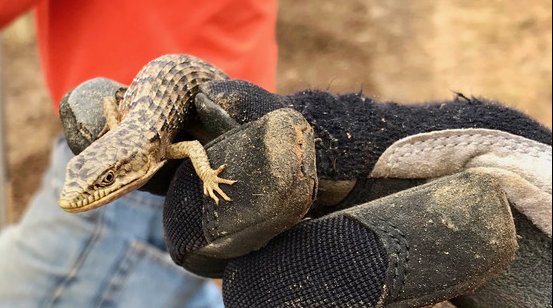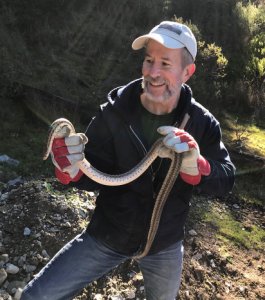
Learn how to wildlife-whisper
Follow Friends of China Camp volunteer Kevin Smead’s simple tips for seeing more animals
Friends of China Camp volunteer Kevin Smead spends hours working at China Camp—hauling fallen trees, repairing damaged trails, and doing myriad other maintenance projects. While Kevin seems tireless, there is something else that makes him extra-remarkable: he finds cool critters seemingly every time he’s out on the trails. Join our volunteer work crews and you’ll probably hear “Look what Kevin found” hollered through the woods. Here, we ask Kevin to share his “wildlife-whisperer” secrets for discovering some of China Camp’s often-overlooked animals.

In my years as a Friends of China Camp trail volunteer, I’ve come across a large number of reptiles, amphibians, and invertebrates. If I’m working on a trail by hand or machine, I keep a close eye on the area I’m disturbing, looking for movement. If I see an animal, I stop and safely relocate it out of harm’s way.
So what have I found? Non-venomous gopher, king, and ring-necked snakes are common. I’m still keeping a careful eye out for my first Western diamondback rattler. In damp environments, I’ve come upon plenty of salamanders, including toothy, tree-climbing arboreal salamanders and aptly-named slender salamanders. I’ve also rescued orange-bellied California newts and greenish-brown Pacific tree frogs.
Among invertebrates, my favorites are the banana slug (too often the slimy victim of a speeding mountain biker) and fearsome-looking scorpions, which would prefer to just be left alone in the decaying wood that they call home.
Tips for discovering China Camp’s most secretive wildlife
For those who wish to increase their odds of observing more of the creatures that call China Camp home, there are some tried and true tactics.
- Spend more time in the park. A casual visitor is likely to encounter the park’s larger and more human-tolerant animals, such as deer, coyotes, raccoons, turkeys, raptors, great blue herons, and snowy egrets. But stick around a while longer, especially at sunset, and you might be lucky enough to encounter a bobcat slinking through the woods, or an endangered Ridgway’s rail poking through the pickleweed.
- Vary your visits. By coming to China Camp in different seasons, under a variety of weather conditions and at different times of day, you’re more likely to witness a changing array of resident and transient critters. Bad weather can be a boon for wildlife watching. On a recent rainy afternoon, I explored an empty Back Ranch Meadows Campground—well, not exactly empty. Some two dozen turkeys were cackling and scratching the ground for food.
- Be patient. It’s amazing how the park comes alive when you pick a spot, remain still, and begin to perceive the nuances of the space around you. Bring a pair of binoculars and a field guide, and perhaps a notebook to jot down observations. You’ll be surprised at how much you’ll be able to witness and identify.
- Hike trails less traveled. Many visitors tend to stick close to sea level, following the Shoreline or Turtle Back trails or hanging out at China Camp Village, the scenic points, or the campground. But climb higher to discover a whole new collection of critters. Trails that wind up San Pedro Ridge—Oak Ridge, Bay View, and Echo trails—rise through oak and bay laurel woodlands and pockets of coast redwood before reaching the summit of 1,000-foot San Pedro Mountain. Look and listen as you climb—maybe you’ll hear pileated woodpeckers hammering on a trunk, or spy secretive varied thrushes scuffing in the duff.
- Join our volunteer trail maintenance crew. Our 15 miles of trails require constant work, and the village, campground, and other facilities need TLC too. Many tasks involve chopping, raking, and scrambling, as well as trimming or removing vegetation large and small. These kinds of activities give you a chance to be in habitats where many of the park’s smaller, often-overlooked animals live. You never know what you may find. Join our trail volunteers and become a critter whisperer too.—reported by FOCC volunteer Kevin Smead

